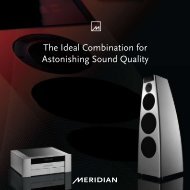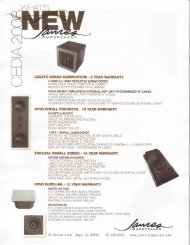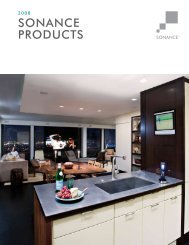Monitor Audio Radius HD Series 5.1 Speaker System Review
Monitor Audio Radius HD Series 5.1 Speaker System Review
Monitor Audio Radius HD Series 5.1 Speaker System Review
- No tags were found...
You also want an ePaper? Increase the reach of your titles
YUMPU automatically turns print PDFs into web optimized ePapers that Google loves.
<strong>Monitor</strong> <strong>Audio</strong> <strong>Radius</strong> <strong>HD</strong> <strong>Series</strong> <strong>5.1</strong> <strong>Speaker</strong> <strong>System</strong> <strong>Review</strong><br />
Brad Copeland<br />
Living in a condo in downtown Toronto, I am reminded every day of the many<br />
things we pass up in the name of convenience and location. A lawn, a deck, a<br />
BBQ, a backyard to throw the football in. All things that millions of others around<br />
the world like myself, have given up in order to live "in the heart of it all". The one<br />
thing I am not willing to compromise on though, is my entertainment system. This<br />
poses a unique challenge, rather unlike the rest of those posed by living in the<br />
close confines of modern urban dwellings. If you have a small living room, you<br />
can get a smaller couch, and it doesn't necessarily mean the couch will be any<br />
less comfortable. Unfortunately though, with a lot of AV gear, smaller usually<br />
equals "less awesome". Whether it's the level of immersion granted by a 100 inch<br />
screen filling your field of vision, or the floor shaking bass of an 18 inch<br />
subwoofer, there is often no substitute for going big. Renowned British speaker<br />
manufacturer <strong>Monitor</strong> <strong>Audio</strong> has attempted to address this unfortunate truth with<br />
their <strong>Radius</strong> <strong>HD</strong> series of speakers, a compact and contemporary line of<br />
freestanding towers, bookshelves, in-wall and in-ceiling speakers. Designed to<br />
faithfully reproduce today's high resolution audio sources while taking up as little<br />
space as possible, the <strong>Radius</strong> <strong>HD</strong> series promise to blend seamlessly with the<br />
decor in just about any room.
The <strong>5.1</strong>-channel R270<strong>HD</strong>10 system which was sent to me for review comprised<br />
of two R270<strong>HD</strong> floorstanding towers ($1299/pair), a pair of R90<strong>HD</strong> bookshelves<br />
($299 each), an R225<strong>HD</strong> centre channel ($499) and an R370<strong>HD</strong> subwoofer<br />
($999). The total for this system added up to $3395. The R370<strong>HD</strong> is the larger<br />
and more powerful model of the two subwoofers in the <strong>Radius</strong> <strong>HD</strong> series, offering<br />
a 10 inch Ceramic-Coated Aluminum Magnesium (C-CAM) driver and a 250 watt<br />
amplifier. Like the more expensive Silver RXW 12 subwoofer, it features a topmounted<br />
panel with a dedicated volume knob and a switch to toggle between two<br />
EQ settings, one for films and another for music. The R270<strong>HD</strong> floorstanders<br />
feature dual 4 inch drivers, a 1 inch C-CAM tweeter and are a bass-reflex design,<br />
with one front and one rear-firing port. The R225<strong>HD</strong>, here positioned horizontally<br />
to act as a centre channel, features two of the same 4 inch drivers and a 1 inch<br />
C-CAM tweeter. These oblong speakers can also be mounted vertically beside a<br />
flat panel, using the included custom wall mount, to act as left and right channels.<br />
<strong>Monitor</strong> <strong>Audio</strong> also makes a larger version called the R250<strong>HD</strong> which features an<br />
extra port, extends a little lower and is designed to complement 50 inch or larger<br />
flat screens. The same C-CAM tweeter and driver are used in the R90<strong>HD</strong><br />
bookshelves, but this time in a single driver configuration. The R90<strong>HD</strong><br />
bookshelves come with a custom wall bracket, and a custom stand is available<br />
as well for those not able or not wishing to mount the brackets on walls.<br />
My review system was sent in a finish <strong>Monitor</strong> <strong>Audio</strong> calls Rosemah, a rich,<br />
tasteful mixture of natural rosewood and mahogany. These cabinets are also<br />
available in piano black, glossy white, a silver lacquer and a natural walnut<br />
veneer. The finish and detailing on all six speakers was impeccable, with<br />
beautifully joined corners giving the appearance that the enclosures were<br />
sculpted from one solid block of wood. The design of the cabinets themselves<br />
was quite elegant, with soft, rounded corners and tasteful, low-profile grilles with<br />
just a hint of the gold coloured C-CAM tweeters visible beneath. <strong>Monitor</strong> <strong>Audio</strong><br />
was kind enough to send a pair of the optional floor stands for the R90<strong>HD</strong><br />
bookshelves. The stands feature a set of speaker wire binding posts at the base,<br />
with speaker wire run internally through the spine of the stand. One only has to<br />
loosen two screws on the speaker itself, slide the speaker onto the waiting pins<br />
on the top of the stand and then re-attach the retaining screws to the back of the<br />
speaker. Mounted on the stands, the bookshelves' tweeters resided just a few<br />
inches above the tweeters of the R270<strong>HD</strong> front stage, giving the whole system a<br />
very cohesive, balanced esthetic. Another nice touch I appreciated was the<br />
pivoting <strong>Monitor</strong> <strong>Audio</strong> logo on the R225<strong>HD</strong> centre channel, which can be rotated<br />
so that it is "right side up" regardless of whether the installation calls for the<br />
speaker to be positioned horizontally or vertically. After 20 minutes or so spent<br />
scrambling around disconnecting my reference Klipsch 7.1 system I slotted the<br />
<strong>Radius</strong> <strong>HD</strong> cabinets into place and stood back to admire what almost seemed to<br />
be someone else's living room! The degree to which the slender R270<strong>HD</strong> towers<br />
and compact sub opened up my room was astonishing. I saw portions of my<br />
walls I haven't seen in two years, and my 60 inch Pioneer plasma looked<br />
absolutely monstrous!
I fired up my reference Pioneer Elite SC-27 AV receiver and ran its Advanced<br />
MCACC room calibration software. It's worth noting that even though the<br />
R270HS fronts and R225<strong>HD</strong> centre have only 4 inch drivers, the MCACC system<br />
recognized them as "large" speakers, which speaks volumes to their low<br />
frequency extension. After making a few adjustments to the MCACC parameters,<br />
I ran the speakers steadily for several days allowing them to break in using both<br />
two and five channel sources. After I felt they had been sufficiently worked in, I<br />
ran the MCACC software again, made a few final tweaks and sat down with my<br />
stack of reference material. Starting out with the DTS-<strong>HD</strong> Master <strong>Audio</strong> track on<br />
the Watchmen Blu-ray disc, I was immediately struck by the clarity and crispness<br />
of the <strong>Radius</strong> <strong>HD</strong>'s tweeters. Delicate high frequency sounds like the glass<br />
breaking as the Comedian goes through the window in the opening scene and<br />
the water rushing off Nite Owl's Owlship were extremely detailed, without being<br />
overbearing, sharp or piercing. The R225<strong>HD</strong> centre channel in particular<br />
impressed me, delivering true, natural sounding dialogue, without any of the<br />
characters sounding boxed-in or tinny. As I mentioned earlier, all the cabinets in<br />
this system share the same 4 inch driver and 1 inch tweeter, and that resulted in<br />
a very even, consistent soundfield, with panning sounds being extremely<br />
consistent and not changing in tone as they moved around the room. I tested this<br />
theory with the underground car chase scene in chapter 20 of Dark Knight on<br />
Blu-ray, which features gunshots striking an armored car which rapidly pan<br />
around the room as the camera changes angles. I was able to clearly place the<br />
bullet impacts around my head with no discernible negative change in tone as<br />
they panned around me. The R370<strong>HD</strong> subwoofer did a commendable job filling<br />
in the low end, unfalteringly reproducing the helicopter blades spooling up in the<br />
opening scene of Transformers on Blu-ray, a sound which starts out so low in<br />
tone it can easily render less capable subwoofers distorted, and in some cases<br />
even physically rattling. My mental opinion of the R370<strong>HD</strong> rose to exemplary<br />
when I considered its diminutive size. It measures only 15"x13"x13", as opposed<br />
to my reference Klipsch sub, also sporting a 10 inch driver, which measures<br />
17"x14"x 19".<br />
One of the things that I was most looking forward to, when I learned I would be<br />
doing this review, was the chance to really put the <strong>Radius</strong> <strong>HD</strong> system through its<br />
paces listening to multi-channel music. I slid the Anniversary Edition SACD of<br />
Pink Floyd's The Dark Side of the Moon into my PS3 with the intention of<br />
listening only to my favourite tracks, the way I usually do for reviews. By the time<br />
I was midway through the third track, "On the Run", with its swirling surround<br />
effects, I was completely captivated, and ended up lapping up the whole album,<br />
beginning to end. The level of detail the <strong>Radius</strong> <strong>HD</strong>s displayed, especially in the<br />
high frequencies, really brought the award-winning mix of music and effects<br />
present in this album to life. By the time I hit the saxophone solo in the middle of<br />
"Money" I was literally bobbing on my couch. I could hear a crisp bite and<br />
detailed vibrato to the sax notes in stark contrast with the mellow filtered guitar<br />
licks keeping time in the background, panning off to the sides of the expansive<br />
soundfield. When the 4/4 beat and guitar solo launched at 3:08, I was able to
fully appreciate the large dynamic range and presence of these speakers, and<br />
when the quiet passage started at around 3:52 and all the other instruments<br />
pulled back, the staccato guitar parts seemed to practically burst from the<br />
speakers while Nick Mason's lazy toms panned across the room.<br />
Perhaps the greatest endorsement I could give the <strong>Radius</strong> <strong>HD</strong> series of speakers<br />
is to say that if I had been wearing a blindfold during testing, not once in a million<br />
years would I have guessed that these speakers were as small as they actually<br />
were. I found their performance to be impressive both with music and film, with a<br />
slight edge going to music, but that isn't really the point of speakers like these.<br />
Lots of companies make impressive-sounding speakers, but I can't say I have<br />
ever encountered a set of speakers that sounds this big while taking up this little<br />
space. Anyone whose "theatre room" occasionally has to pull duty as a regular<br />
living room (i.e. most of us) owes it to themselves to consider the <strong>Radius</strong> <strong>HD</strong><br />
when looking for a set of compact, but only in size, speakers.<br />
Manufacturer:<br />
<strong>Monitor</strong> <strong>Audio</strong><br />
www.monitoraudiousa.com<br />
Distributed in Canada by Kevro International Inc. 905-428-2800














